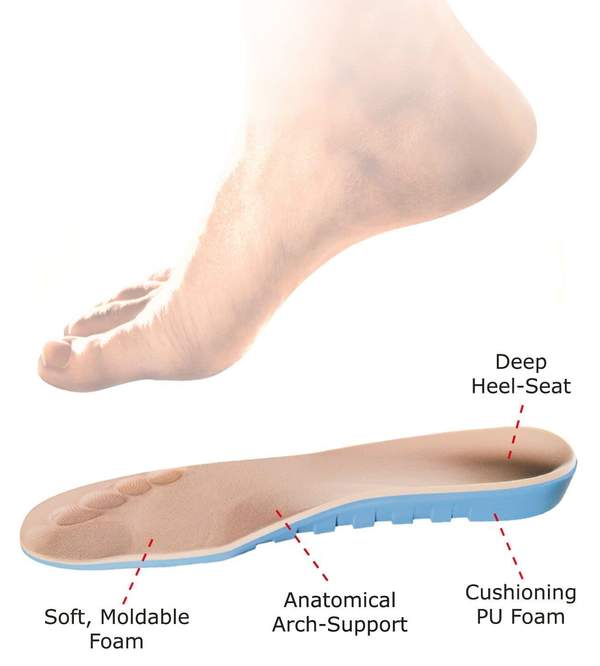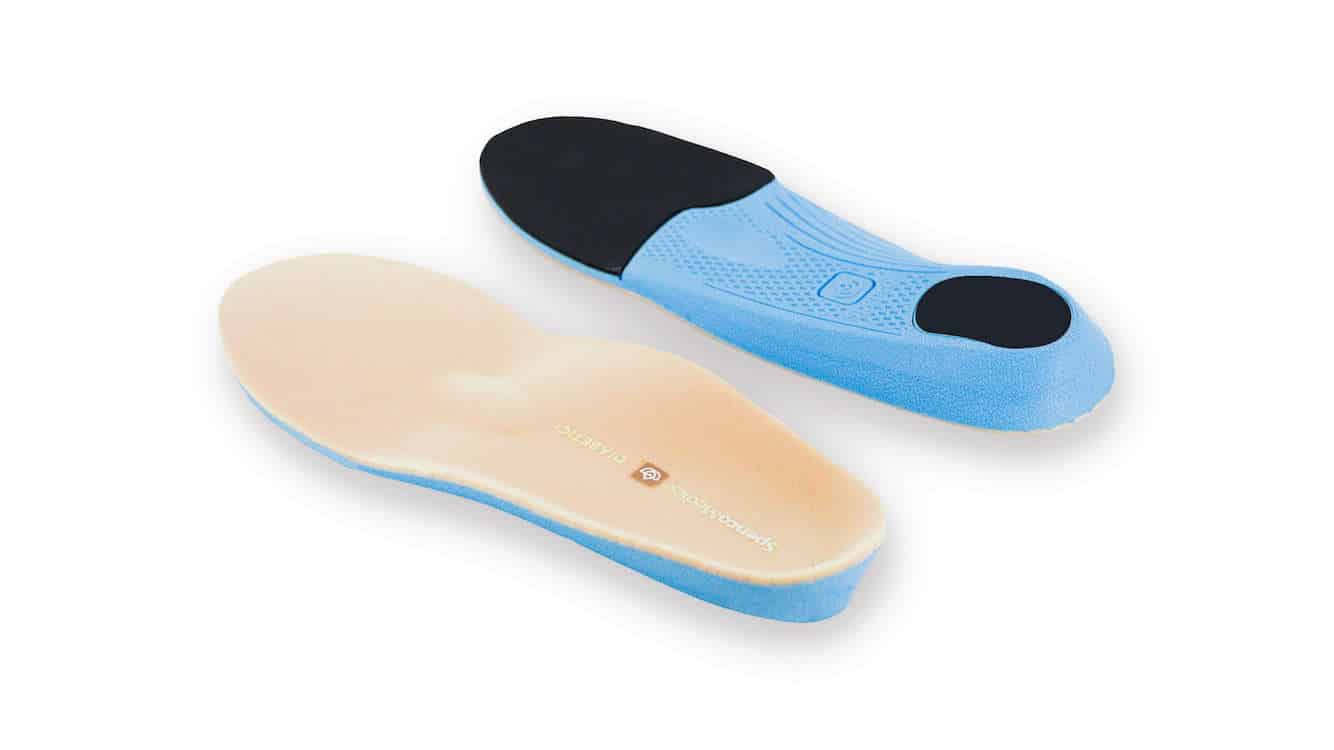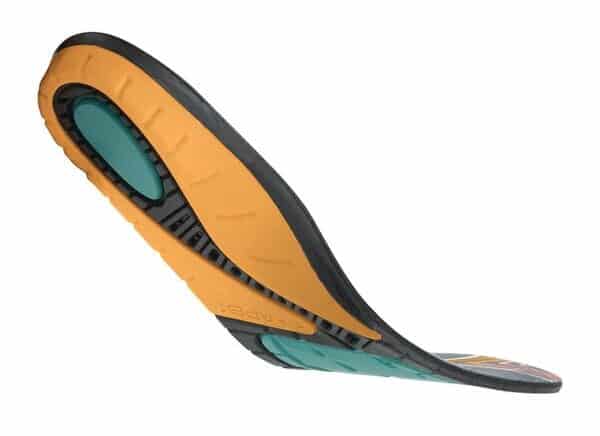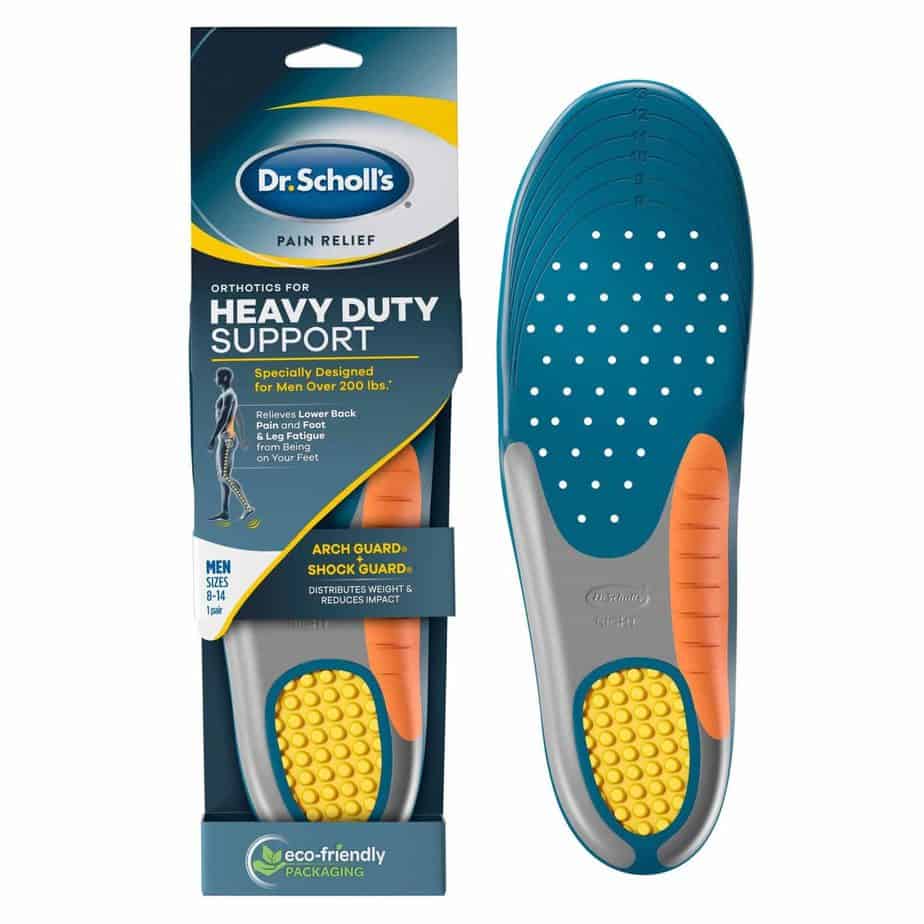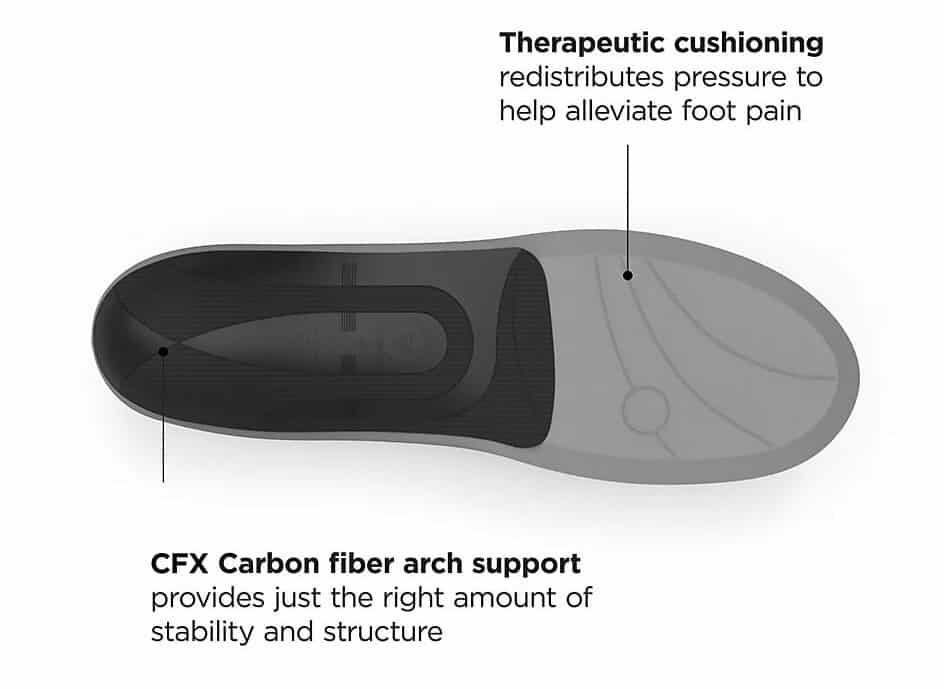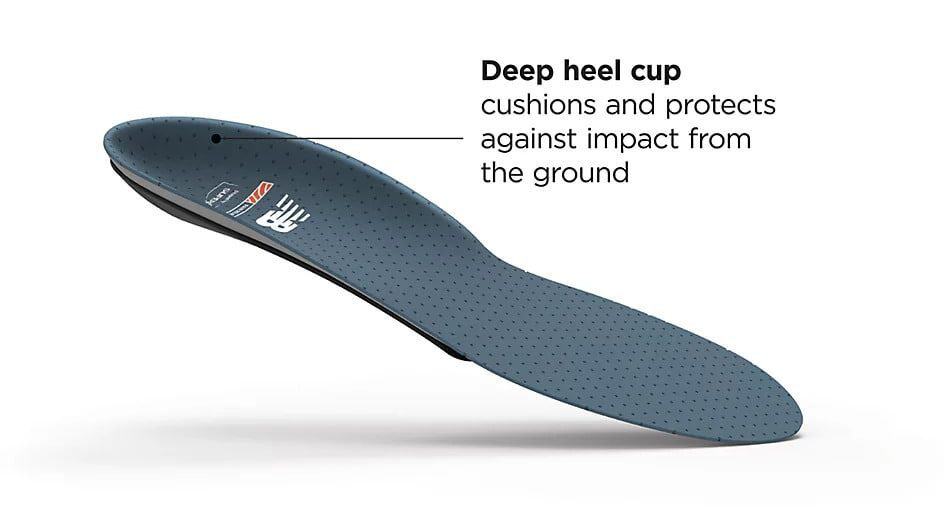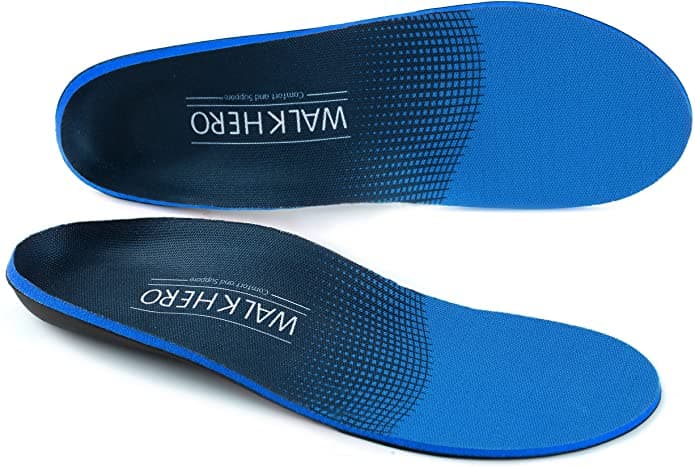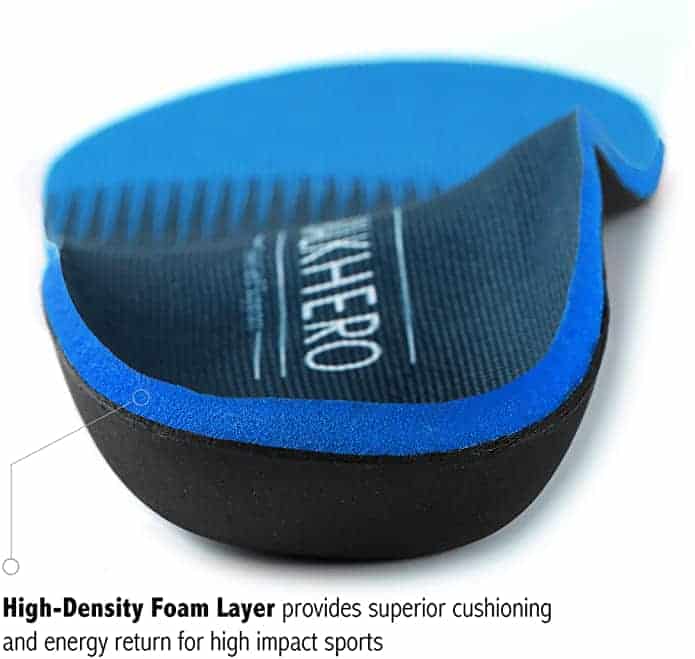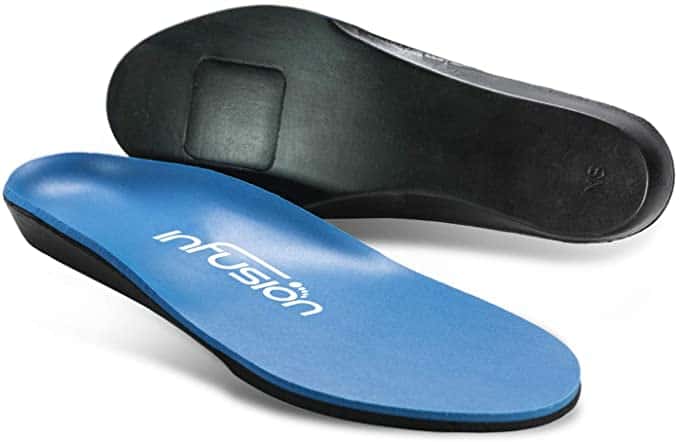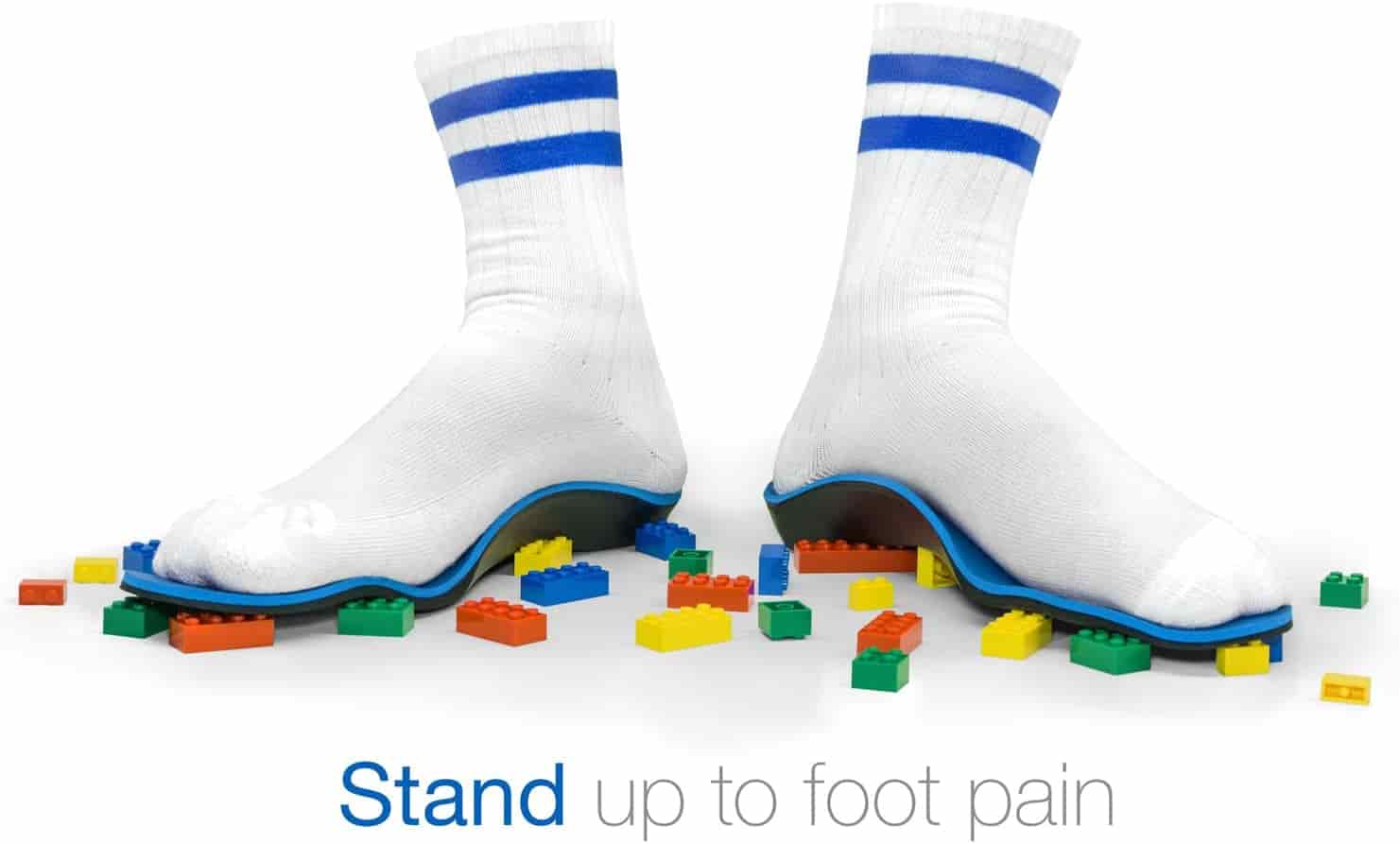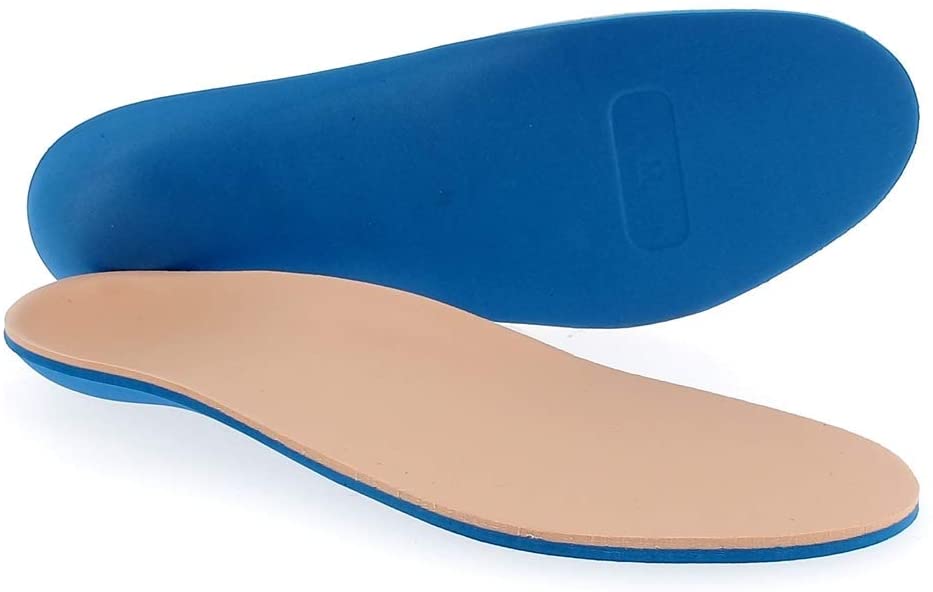10 Great Diabetic Insoles, Orthotics & Shoe Inserts for Neuropathy

Diabetic insoles, also called shoe inserts or orthotics, can help with diabetes and neuropathy foot pain. If you regularly read my blog, you know I’m pretty skeptical about the so-called “diabetic” products that everyone’s trying to sell us. But regarding orthotics, there’s a need here.
I’ve researched and selected the ten best insoles for diabetes and neuropathy in 2022. Please read the reviews carefully: each orthotic has its specificities, so be sure to choose the right one for your own feet!
These insoles are particularly helpful if you have a pair of favorite shoes that might not be perfectly made for people with neuropathy. The insoles help you to ‘upgrade’ the shoe, even when it is not a model designed specifically for people with diabetes and neuropathy. If picking and fiddling with insoles is not your thing, you find an updated list of the best shoes for diabetes and neuropathy we put together here.
Table of Contents
Best Diabetic Insoles for Diabetes and Neuropathy Foot Pain
Orthofeet BioFit Soft Insoles for Diabetic Foot Pain Relief
- #1 Orthotic footwear company
- Superior shock absorption
- Pressure dispersion
- Anatomical arch support
- Dynamic foot contour
- Soft & moldable cushioning foam
- Deep heel cup
- 60-days wear test
Orthofeet BioFit Soft Diabetic Insoles
Orthofeet is the #1 diabetes and neuropathy footwear brand recommended by foot professionals. The company has designed four different styles of orthotics. The BioFit one is the most suitable for diabetes & neuropathy patients. It’s a soft cushioning that brings moderate support. It features advanced foot, knee, and back pain relief properties.
The shock-absorbing foam is excellent and relieves pressure on the bottom of the foot all along the sole. Comfortable arch support provides good stability and reduces foot stress.
Unlike other companies, Orthofeet crafts its shoe inserts on a separate mold for each shoe size and width. It ensures a more precise and customized fit, which is essential when choosing insoles. These insoles are not unisex. There’s one model for women and one for men.
Last but not least, there’s a 60-day wear test and 100-money-back guarantee on Orthofeet’s website. I find it very valuable when buying footwear products online that you can’t try out first.
- Details
- Men shoe size: 7 to 15
- Women shoe size: 5 to 12
- Extended widhts available
- Free shipping on continental US orders - Free returns
Best Diabetic Shoes Inserts for Sensitive Foot Skin
Spenco Medics Anti-Friction Plastazote Diabetic Insoles
- Designed for diabetics
- Arch support footbed
- Deep heel cup
- Rearfoot stability
- Central uplift
- Blister-guard Plastazote
- SpenCore memory foam
- Great shock absorption
- American Podiatric Medical Association
Spenco Medic Anti-blister Insoles for Diabetes & Neuropathy
Spenco Diabetic+ Insoles have been specially designed for people with sensitive feet, diabetes, and neuropathy. They aim to provide ultimate comfort and protection for delicate feet. The central uplift is a great feature that improves foot stress-releasing function.
What’s best about these soft diabetic inserts is the top-quality materials they’re built in. Spenco has patented a SpenCore memory foam known to be one of the most shock-absorbing and impact-reducing foams.
The anti-blister plastazote top cover reduces friction and protects sensitive feet against blisters and wounds. Plastazote insoles work great for people with sensitive skin, diabetes-related foot problems, and neuropathy foot pain.
The American Podiatric Medical Association officially approves Spenco shoe inserts.
Best Diabetic Insoles for High and Medium Foot Arches
Apex A-Wave Orthotic Inserts with 3 Levels of Supports
- Customised to your arch height
- 3 levels of support
- Pain-relieving cushioning
- Memory foam & gel
- Great cushioning
- Great foot support
- Improved stability
- Heel lift
- Free shipping & free return
Apex A-Wave Orthotic Inserts for Diabetes
Apex is an iconic orthopedic footwear company offering an incredible product catalog for diabetics, including shoes, socks, and insoles. There’s only one style of shoe inserts available here, but it comes in 3 different levels of support depending on your arch type. Choosing the shape and approval of your insoles according to your foot arch is essential.
If you have low arches, you should get the extra firm ones. If you have medium arches, select the firm one. And if you have high foot arches, contact the flex insoles.
These are made from a patented blend of thermoplastic resins, memory foam, and supportive gels. Customers are satisfied and report efficient pain-relieving effects!
Best Diabetic Shoe Inserts For Heavy Duty Support
Dr. Scholl’s Heavy Duty Pain-relief Orthotics for Diabetics
- Heavy-duty insoles
- Excellent weight distribution
- Anti-fatigue
- Foot, leg & back pain-relief
- Reinforced arch support
- Full length cushioning
- Impact reduction
- Heel shock-guard technology
- Trim-to-fit insoles
- Fit casual shoes
- Money-back guarantee
- Great value for money!

Dr. Scholls Heavy Duty Pain-relief Orthotics
Dr. Scholl offers a vast catalog of orthotics. Whether you need orthotics for foot pain relief, plantar fasciitis, heel pain, sore soles, or ball of foot pain, there’s Dr. Scholl’s insole for you.
I’ve chosen the heavy-duty pain relief orthotics because they bring something different from regular diabetic insoles. They’re designed to alleviate foot, leg, and back pain for men over 200lb. The weight distribution system is better than any other insoles. The shock-guard technology absorbs pain-inducing shocks in the heels.
These trim-to-fit insoles fit casual shoes. Dr. Scholl’s insoles are very reasonably priced. There is a similar extra-support insoles model for plus-size women.
Best Insoles for Diabetic Neuropathy & Foot Fatigue
New Balance & Superfeet Casual Pain-Relief Insoles
- Made with Superfeet insole shape
- Flexible arch support
- Reinforced heels
- Impact reduction
- Plush foam cushioning
- Anti-fatigue design
- Pressure-relief
- Moisture-wicking & anti-bacterial
- Ideal for sensitive skins
- Trim-to-fit insoles
- Fit regular-width shoes!
New Balance Pain-Relief Insoles for Neuropathy
You’ve probably heard about the iconic New Balance casual sneakers before. Did you know the Boston footwear company offers a complete product line for people with diabetes? Medicare and other health insurance providers even cover New Balance diabetic shoes.
New Balance cushioned insoles are shaped by Superfeet, one of the USA’s top orthopedic insoles companies. Superfeet’s patented shape is notorious for providing a supportive and energizing shoe foundation.
Two layers of plush foam relieve pressure on your feet, and the reinforced heels add protection against impacts. The fabric is moisture-wicking and odor-controlling, keeping your feet in a dry and healthy environment away from fungus infections. These insoles are super soft and ideal for sensitive skins that need blister-guard shoe materials.
New Balance insoles are great for people with neuropathy who need extra comfort, light support, and a super-protective material. They fit into most regular-wide shoes.
Best Insoles for Diabetics' Plantar Fascitiis Pain
WalkHero Arch Support & Pain-Relief Orthotics
- Amazon best-seller
- Recommended for diabetes
- Reduces foot pressure
- Relieves soreness
- Enhanced arch support
- High-density foam
- Deep stabilizing heel cup
- Great shock absorption
- Fits into any shoes
- Reduces friction
- Keeps feet coolction
Walk Hero Insoles for Plantar Fasciitis & Diabetes Foot Pain
Walkera is an iconic insole company. For this style only, you can read more than 47,000 costumers reviews on Amazon! These semi-rigid full-length insoles are made with premium cushioning and shock-absorbing materials. They’re engineered to reduce foot stress and alleviate foot pain due to diabetes, plantar fasciitis, flat feet, arthritis, and more.
You’ll get maximum comfort and cushioning. The deep heel cup helps stabilize the foot while walking and the arch support is good. The durable velvet cover is anti-bacterial to keep your feet healthy—a great choice for a reasonable price (&18.99).
Best Massaging Gel Shoe Insert for Neuropathy & Diabetes
Dr. Scholl’s Massaging Gel Advanced All-Day Relief Insoles
- All-day comfort
- Multi-layer gel waves
- Relaxing & pain-relieving
- Anti-fatigue & energizing
- Shock-absorbing
- Great cushioning
- Arch support
- Added heel support
- Great value for money!
- 90-days money back guarantee
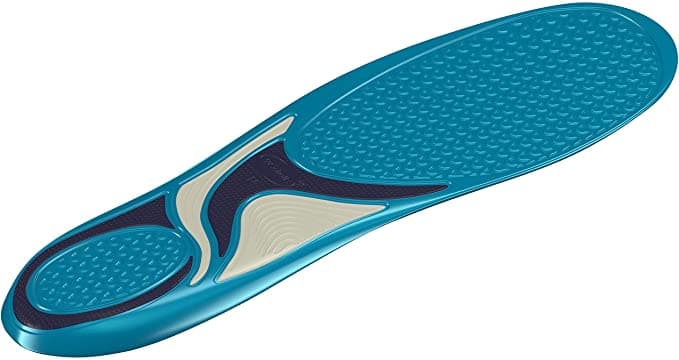
Dr. Scholls Gel Inserts for Neuropathy
Another great product from the iconic Dr. Scholls. The Gel massaging insoles have been designed for people with foot fatigue and foot pain. They’re a great addition to your arsenal of gear against neuropathic pain.
The multi-layer gel waves act to absorb shocks and gently massage your feet during the day. It reduces foot and leg fatigue and energizes the lower limbs while relieving pain and discomfort.
There’s excellent cushioning and proper foot arch and heel support. Definitely worth the try, especially for such a great price ($12.99 only!).
Best Moisture-wicking Diabetic Orthotics for Sweaty Feet
Infusion Ultra-Soft Poron Insoles for Diabetes and Neuropathy
- Foot pain relief shoe inserts
- Ultimate cushioning - 8mm thick insoles
- 25mm Deep heel cup
- Extra-soft cushioning arch support
- Bi-laminate high impact materials
- Poron doesn't flatten out over time
- Moisture-wicking
- Anti-bacterial & anti-fungus
- High-volume
- Trim-to-fit insoles
- Long-lasting quality
- Made in USA
Infusion Ultra-Soft Poron Insoles for Diabetes and Neuropathy
The Cloud Walker insoles by Infusion Insoles are perfect for people who need extra-soft cushioning due to diabetes or neuropathy foot pain. The material is highly shock-absorbing, even for tangible impacts on the foot. The heel cup is 25mm deep, ideal for foot stability and motion improvement.
They’re built with a combination of medical-grade Poron and Polyurethane layers. Poron is a polyurethane foam that wicks moisture away and helps keep your feet in a dry and healthy environment. It’s ideal for people who tend to have sweaty feet and fungus infections. Poron insoles are long-lasting quality orthotics.
These trim-to-fit insoles are thick and won’t fit in every regular-width shoe. They might work in your regular sneakers or walking shoes if these are not too tight.
Best Semi-Rigid Full-length Insoles for Diabetes & Neuropathy
PowerStep Pinnacle Full-length Arch Support Orthotics
- Designed to alleviate foot pain caused by plantar fasciitis, foot pronation, metatarsal, flat feet, sore and tired feet
- Semi-rigid arch support
- Suitable for all foot arch types
- Deep heel cradle
- Motion control
- Premium thick cushioning
- Heat-controlling
- Anti-microbial and odor-free
- EVA foam durable sole
- Made in USA

PowerStep Pinnacle Full-length Arch Support Orthotics
For 30 years, PowerStep has been a leader in providing clinically proven foot pain relief solutions. The Pinnacle shoe inserts are a best-selling product and are well-famous among diabetic and neuropathy patients.
The arch support is neutral and semi-rigid. It’s firm and flexible simultaneously and suits all arch types (low, neutral, and high arches). The premium cushioning technology uses two thick layers of plush fabric, and the sole is made from EVA durable foam.
PowerStep Pinnacles inserts provide your feet with optimum support, comfort, and shock absorption while correcting posture towards proper foot alignment. These insoles fit many shoes with removable insoles, including most diabetic and neuropathy shoes.
Where to buy PowerStep insoles?
PowerStep Pinnacle insoles are considerably cheaper on Amazon than on the company website. If you want to try them out before buying, they’re available in most orthotic footwear stores in the USA.
Cheapest Diabetic Insoles & Orthotics
Inocep Therapeutic Shoes Inserts for Diabetics
- Designed for diabetics
- Cloud-like cushion
- Ultra-lightweight
- Heat-moldable
- Shock absorption
- Arch support
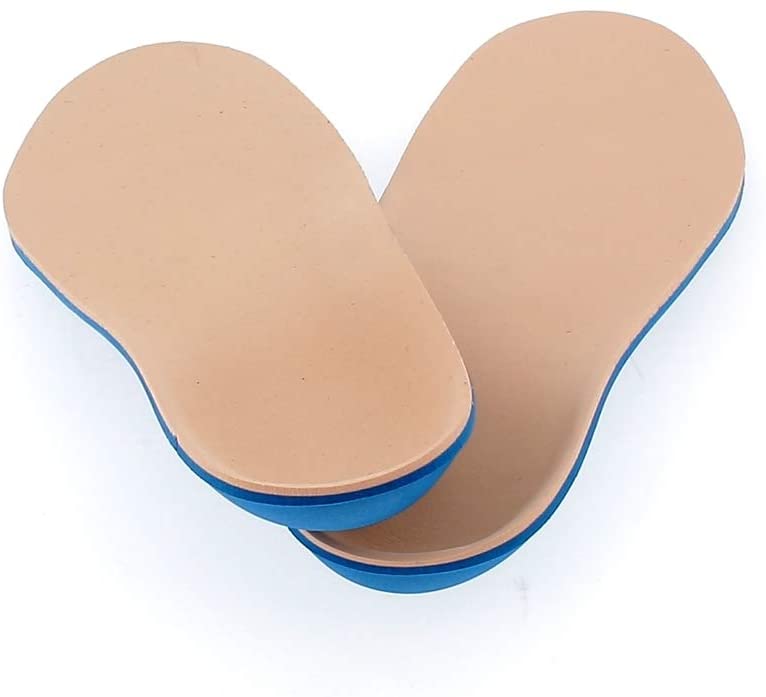
Inocep Therapeutic Shoe Inserts for Diabetics
Inocep Therapeutic shoes inserts for people with diabetes are probably the best price you can get. Of course, you can’t expect the same quality and durability as other products, but they do bring extra foot comfort and protection to people with diabetes.
What’s best about them is that they’re heat-moldable, so you can customize them to your foot shape. To mold your inserts home, put them in the oven (200F) for 3 minutes. Then immediately place them into your shoes and insert your feet. Stand up straight for another 2 minutes while they shape. That’s it!
Inocep diabetic shoe inserts cost $12.99 only on Amazon and can be returned for free if you’re unsatisfied.
Diabetic Insoles and Shoe Inserts for Neuropathy: FAQ
Let’s take a dull terminology moment before we start. I sometimes talk about insoles, shoe inserts, orthotics, or sock liners. There used to be a difference. Originally, orthotics were custom-made insoles meant to correct posture (which insoles did not). Since hundreds of companies entered the game, the distinction has lost meaning. Each one calls its foot accessories the way it pleases without respecting any rule.
So, inserts, orthotics, insoles, sock liners… call it whatever you like. Just be sure you’re buying something good for yourself!
What are Diabetic Insoles?
An insole is a removable footbed that can be added or removed inside your shoes, sneakers, boots, sandals, or any shoe. Most factory-made shoes come with basic pointless insoles. They are adding shoe inserts that foot specialists have designed that can serve many purposes, from improved comfort, plantar fasciitis treatment, arch support, and foot pain relief to motion aid, orthopedic or postural correction, and even optimized athletic performances.
Diabetic insoles and insoles for neuropathy are shoe inserts precisely designed to alleviate foot pain caused by diabetic neuropathy and protect your feet from further problems. They generally feature extra-cushioning, anatomical arch support, pressure-relief properties, anti-friction and blister-guard materials, and a good shock absorption capacity.
Most diabetic shoes already come with built-in or removable diabetes-friendly inserts. But you can also wear regular shoes with an additional diabetic insole that will improve comfort and protection.
Why Do Diabetics Need Orthotics?
First, let’s clarify. Not all diabetics need diabetic orthotics. Diabetic orthotics are not made for people with diabetes but for diabetic foot problems! Suppose you don’t have any foot problems and dominate diabetes management. In that case, chances are you don’t need anything but good quality shoes and protective socks.
People living with either type 1 or type 2 diabetes are more prone to developing severe foot conditions than the general population. There are three main reasons why people with diabetes need suitable orthotics:
Alleviate Peripheral Neuropathy Foot Pain
Most foot problems people with diabetes suffer from are due to peripheral neuropathy. This serious diabetes complication affects the nerves in the lower limbs. Insoles for neuropathy have proven to alleviate the extreme foot pain caused by neuropathy symptoms (tingling, burning, sharp pains, cramps, extreme sensitivity, etc.). They also play a key role in preventing foot injuries in neuropathy patients, especially foot ulcer.
Plantar Fasciitis and Diabetes
People with diabetes are more at risk of developing plantar fasciitis, an inflammation of the tissue in the heel. The main symptom is stabbing pain in the heel area. One of the most recommended treatments is proper shoe inserts.
Extra Comfort and Preventive Protection
I’m not saying you must wait and suffer before getting orthotics. Appropriate footwear plays a significant role in preventing foot problems in diabetic patients. Even if you haven’t been diagnosed with neuropathy or plantar fasciitis, providing your feet with extra comfort and protection is always a good idea. It’s part of the daily recommended foot care routine for people with diabetes.
Do Shoe Inserts for Neuropathy Really Work?
Yes. If you regularly read my blog, you know I am often skeptical about the so-called “diabetic” products everyone’s trying to sell us. Not this time.
Diabetic footwear for people with peripheral neuropathy does make a huge difference. Not only can it alleviate foot pain, but it also prevents further problems from showing up.
Neuropathy insoles are designed to soothe your feet, support them, improve motion, provide extra cushioning, absorb shocks and impacts, and prevent skin frictions that could lead to blisters and infections.
Diabetic Insole Guide: How to Find the Best Inserts for Your Feet?
Before choosing insoles for diabetes or diabetic neuropathy, there are a few features you should pay attention to. Wearing orthotics that do not suit your foot type will do you more harm than good.
Here’s a little help to guide you through the essential features to look for in shoe inserts. It would help if you also first asked for your doctor’s or podiatrist’s advice.
Insole Size Chart & Fit-to-Trim Inserts
Insole sizes usually refer to a shoe size range. For example, “Women’s 5-7”. Most factory-made insoles are meant to be trimmed off. It allows you to find the perfect fit. If you’re in between sizes, you should buy the next size up and trim the unneeded length.
Full-Length or 3/4 Shoe Inserts?
Full-Length orthotics are the most commonly used by diabetes and neuropathy patients. They extend through the entire foot length and are meant to replace the existing shoe insert.
3/4 length insoles are shorter. They extend from the football (behind the toes) to the heel. They’re meant to be placed on top of your existing shoe inserts. People with hammertoes or bunions usually prefer 3/4 orthotics. If your shoes are a bit tight (narrow-toed shoes), they’re also more suitable.
High-volume Vs. Low-volume Insoles
The insole volume is the amount of space it takes inside your shoes. Logically, high-volume footbeds will take more room and provide more cushioning than low-volume ones.
People with diabetes or neuropathy must wear non-binding footwear. Shoes that are too tight constrict your legs and impede proper blood flow.
Choosing the right diabetic orthotics volume depends on the shoes you place them in. If you have extra-wide shoes for diabetics, consider high-volume insoles for more cushioning. But if you’re wearing regular-width shoes, you might be better with a bit less cushioning and more room. In that case, choose medium or low-volume inserts.
What's Your Foot Arch Type?
There are three-foot arch types, and you should be one of them. You’re either neutral arch, low arch, or high arch. A picture is worth a thousand words:

You can also do the water or wet test to determine your arch type. Knowing your foot arch type is essential, as most insoles are designed for one arch type only. Wearing insoles made to support a high arch if you have a low angle can be painful and do you more harm than good.
Insole Footbed: Rigid vs. Cushioning Arch Support?
Like all orthotics, orthotics for diabetics come with four different footbed options. The rigid footbed is the one providing the most robust arch support. It can be challenging to wear, and it’s advisable to seek your podiatrist’s advice before using rigid arch support. The semi-rigid footbed provides good arch support but is more flexible. It’s easier to wear and ideal for most people.
Then, there are the cushioned arch support and the flat cushion (no arch support). They are fine for people with diabetes who are not experiencing plantar fasciitis or foot arch pain. You should generally choose rigid or semi-rigid arch support if you suffer arch pain. Cushioned or flat support won’t do anything for you.
Foam Inserts Vs. Gel Inserts
Most diabetic insoles are made from foam or gel. Foam is better for cushioning and pressure relief. The gel works excellent for shock absorption. Memory foam insoles shape your own feet, which is quite pleasant. Gel insoles act more like a foot massage, which is also lovely. A significant advantage of gel insoles is that they generally are anti-bacterial and machine washable.
Orthotics for Diabetes and Neuropathy: Frequently Asked Questions
Can you wash your shoe inserts?
Yes, and you should. The foul smell of shoes often comes from the insoles themselves. Regularly washing your orthotics helps keep your feet in a healthy environment and prevents bacteria and fungal growth.
Only a few insoles are machine washable, though. You can wash gel insoles in the machine at cold temperatures. For foam insoles, it’s better to hand wash them. There are several methods to cleanse your insoles without deteriorating them. You can use warm water and soap, vinegar, or baking soda.
How long do orthotics last?
Custom orthotics can last up to three years if you take good care of them. Most ready-made shoe inserts don’t last as long, and you usually have to change them every six months. There are clear signs that indicate it’s time you get new insoles: deformation, damage, foul odor, and especially if they’re flatter than they used to be.
Can you put insoles on top of insoles?
It sounds like a stupid question, but it’s not! You should remove your shoe insoles before placing custom-made orthotics. For full-length insoles, it’s best to remove your original insole too, but it’s not obligatory. If you feel more comfortable and your feet have enough space, you can keep the original insole under the new one. On the contrary, 3/4 length shoe inserts are supposed to be placed on top of your shoe insoles.
Does Medicare cover diabetic shoes and inserts?
Medicare does cover orthotic shoes and inserts for people with type 1 to type 2 diabetes who qualify under Medicare Part B. The shoe inserts must be prescribed by a podiatrist, an orthotist, a prosthetist, a pedorthist, or any other qualified doctor.
Some private medical insurances in the US also cover part of the cost of therapeutic footwear for people with diabetes. Check with your insurance provider.
Are custom-made insoles worth it for diabetes and neuropathy?
Custom-made orthotics can cost between $250 and $1500 and are usually not covered by medical insurance. The process takes a long time and several appointments with specialists who thoroughly examine and cast your feet. Custom orthotics make the difference if you have severe foot conditions such as advanced neuropathy, foot ulcer, foot deformation, chronic pain, or tendinitis and can afford the price.
However, ready-made insoles are enough for most people, including diabetes and neuropathy patients.
What are acupressure insoles?
Acupressure insoles are magnetic therapy shoe inserts covered with plenty of tiny magnetic nodules. Their action is based on reflexology, an alternative medical practice relying on the idea that every area of your feet is linked to a part of your body. They provide a massaging effect and claim to be an effective foot pain relief solution.
What are magnetic shoe inserts' benefits for neuropathy?
As I said above, magnetic acupressure shoe inserts work on the principles of reflexology. The tiny magnets gently apply pressure on the acupoints of your feet. If you believe in reflexology, using magnetic insoles is something your should try.
Reflexology insoles claim to alleviate foot pain and boost blood circulation. Both effects are very beneficial to people with diabetic neuropathy. If you don’t believe in the idea behind acupressure insoles, the worst-case scenario is that you’ll have a good foot massage!
I’ve researched the Carespot Gel Acupressure Foot Therapy Inserts and have the best customer reviews of all magnetic shoe insoles.

